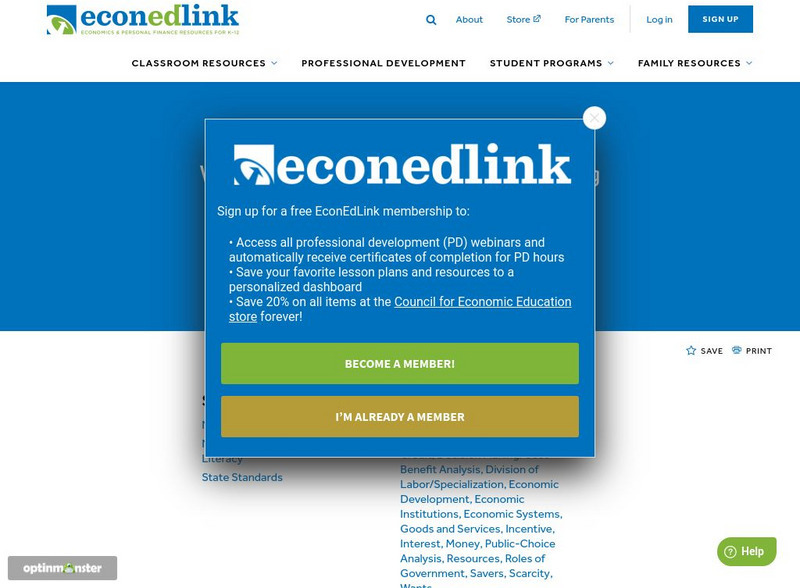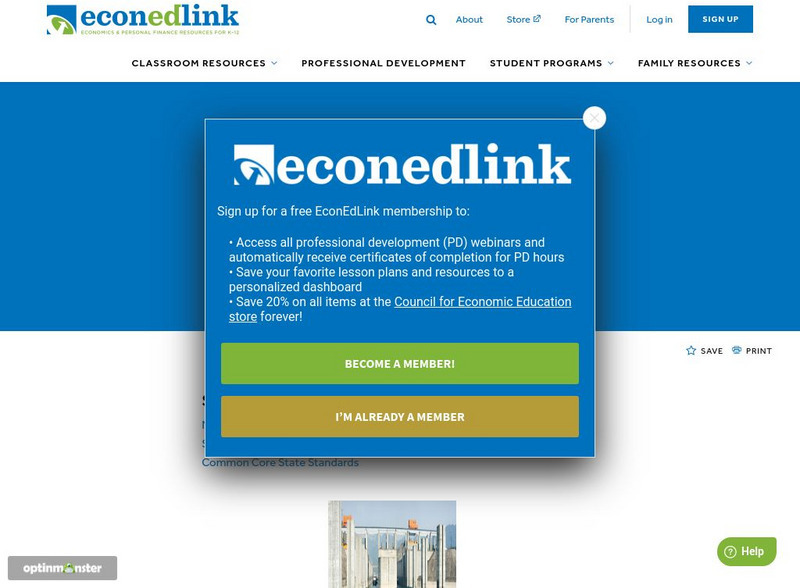Council for Economic Education
Econ Ed Link: Lemonade for Sale!
Middle schoolers will become online entrepreneurs, taking risks and changing their production method to increase their profit while running a lemonade stand. This lesson might best be taught after students have learned about the basic...
Council for Economic Education
Econ Ed Link: The Civil War: A War of Resources
The North won the Civil War in large part due to its superior resources. In this lesson students will learn the difference between capital resources, human capital, and natural resources. They will investigate and compare the resources...
Council for Economic Education
Econ Ed Link: Work, Earnings and Economics: Using Lyddie by Katherine Paterson
In reading and discussing Lyddie, by Katherine Paterson, students examine basic economic concepts and explore the growth of labor unions and the role of government in a market economy.
Council for Economic Education
Econ Ed Link: The Choice Is Us: Monopolies
This instructional activity introduces the concept of monopoly. It calls upon learners to consider how monopoly power might affect the quality and price of goods and services offered to consumers. In light of what they learn about the...
Council for Economic Education
Econ Ed Link: The Higher You Climb, the More You Pay
Young scholars will take a "Virtual Tour" of the Eiffel Tower in Paris France and locate the price of a bottle of water at each viewing platform. They will need to problem solve how to pay for admission, buy the water and be able to pay...
Council for Economic Education
Econ Ed Link: The Price of Gasoline: What's Behind It?
In this lesson plan, students investigate the variables that contribute to the cost of gasoline. They learn that while OPEC nations do influence the price of oil and thus the price of gasoline, other factors also influence the price.
Council for Economic Education
Econ Ed Link: No Fireworks on the 4th of July
This lesson explores the differences between public and private goods.
Council for Economic Education
Econ Ed Link: Fad or Fortune
This lesson focuses on collectibles and how they retain, lose, or gain value. In each round of a trading simulation, students will learn more about the value of their collectibles and discuss why items gain or lose value. They will...
Council for Economic Education
Econ Ed Link: Sand Art Brownies
In this lesson, you will learn about substitute goods. You will have choices to make in your role as a shopper. In making these choices, you will decide whether you are willing to accept one good as a substitute for another or not. Are...
Council for Economic Education
Econ Ed Link: Agent Pincher: The Case of the Missing Susan B. Anthony Dollar
Agent Penn E. Pincher is again called out on a case. It seems that in 1979 the U.S. Bureau of Engraving launched a new one-dollar coin. However, most citizens haven't seen it in several years. This case may be from the cold case files....
Council for Economic Education
Econ Ed Link: Agent Pincher: P Is for Penny or Where Did Money Come From?
What if we woke up tomorrow and found that there were no more pennies? Or what if we found that money had disappeared altogether -- not only from our pockets but from banks, stores and all the other places where we would expect to find...
Council for Economic Education
Econ Ed Link: Cost/benefit Analysis: Three Gorges Dam
This lesson will allow middle schoolers to evaluate the costs/benefits of the Three Gorges Dam project on the Yangtze River in China. The purpose of this lesson is to encourage students to look at a complex issue from differing...
Council for Economic Education
Econ Ed Link: Where's the Beef?
Students explore meat consumption statistics, an indicator of a nation's relative prosperity and standard of living. They do a survey of a family's meat consumption and compare their results to statistics from Colonial and modern- day...
Council for Economic Education
Econ Ed Link: Lewis and Clark Barter With the Native Americans
Using the study of the Lewis and Clark expedition students will define the term barter and give examples of bartering.
Council for Economic Education
Econ Ed Link: Who Is Working?
This lesson teaches students what economists mean when they talk about people who are employed, unemployed, and not in the labor force. It discusses the Current Population Survey and asks students to pose as government survey workers to...
Council for Economic Education
Econ Ed Link: All in Business
This instructional activity on entrepreneurship can be used to help students understand what innovations are, and what it takes to get an idea off the ground. This instructional activity will take students through the process of...
Council for Economic Education
Econ Ed Link: How the Crusades Led to the Finding of the New World
The instructional activity will help learners to discover the importance of the Crusades to the expansion of many European countries. Students will also be introduced to new products and find out why explorers were willing to risk all to...
Council for Economic Education
Econ Ed Link: It Pays to Stay in School
This lesson examines some of the incentive programs being offered to keep students in school
Council for Economic Education
Econ Ed Link: Why Adopt a Highway?
Students learn about the successful Adopt-a- Highway program and how it can save governments and taxpayers money.
Council for Economic Education
Econ Ed Link: The Penny Problem
Middle schoolers will research the cost of making the penny an the use of the penny and come up with reasons why the penny should or should not be continued to be made and used.
Council for Economic Education
Econ Ed Link: Capital Chips (Part 3)
Through the use of a historical timeline of the capital investments made by the company the resulting benefits will be examined. The benefits from the capital investments of Herr Foods, Inc. will be related to their effect on the...
Council for Economic Education
Econ Ed Link: Capital Chips (Part 2)
Through the use of a historical timeline of the capital investments made by the company the resulting benefits will be examined. The benefits from the capital investments of Herr Foods, Inc. will be related to their effect on the...
Council for Economic Education
Econ Ed Link: Capital Chips (Part 1)
Through the use of a historical timeline of the capital investments made by the company the resulting benefits will be examined. The benefits from the capital investments of Herr Foods, Inc. will be related to their effect on the...
Council for Economic Education
Econ Ed Link: The Need for Money That Everybody Can Use
The U.S. Currency currently has two faces. The old bills are being replaced with new designs. The study of the look of the bills will lead into a discussion of their usefulness for a segment of our population: the visually impaired people.





